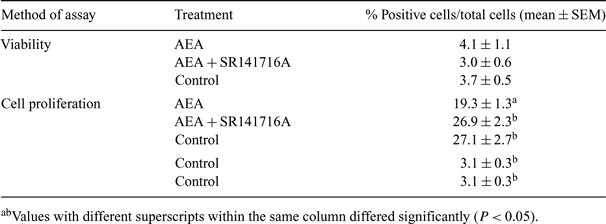179 EFFECTS OF AN ENDOCANNABINOID, ANANDAMIDE, ON BOVINE BLASTOCYST DEVELOPMENT IN VITRO
M. Y. Turco A , K. Matsukawa A , P. Loi A and G. Ptak ADepartment of Comparative Biomedical Sciences, University of Teramo, Teramo, TE, Italy
Reproduction, Fertility and Development 18(2) 197-197 https://doi.org/10.1071/RDv18n2Ab179
Published: 14 December 2005
Abstract
Cannabinoids cause many adverse effects on reproductive functions including fetal loss and pregnancy failure (Paria et al. 1995 PNAS 92, 9460–9464). N-arachidonylethanolamine (anandamide), an endogenous cannabinomimetic lipid derivative, binds with high affinity to brain type and spleen type cannabinoid receptors (CB1-R and CB2-R) and mimics most of the effects of Δ9-tetrahydrocannabinol [(−)THC], a psychoactive derivative of marijuana. In this study, we investigated the effects of anandamide on ovine blastocyst development in vitro. In vitro-matured oocytes were chemically activated and cultured to the blastocyst stage in our standard media (Ptak et al. 1999 Biol. Reprod. 61, 1568–1574). The development rate of blastocysts was 41%. Day 7 blastocysts were exposed to 28 nM anandamide with or without 20 nM SR141716A (an antagonist of CB1-R) for 48 h. In Experiment 1, we examined the CB1-R protein localization on blastocysts by anti CB1-R antibody (Santa Cruz Biotechnology, Inc., Santa Cruz, CA, USA). In Experiment 2, to investigate the possible effect of anandamide on blastocyst development, we used the cell viability assay by propidium iodide, a cell proliferation assay (5-bromo-1′-deoxyuridine incorporation), and the terminal deoxynucleotidyl transferase-mediated dUTP nick-end labeling (TUNEL) assay (Qbiogene, Inc., Carlsbad, CA, USA). Data were analyzed by one-way ANOVA. CB1-R signals were detected on ovine blastocysts, and these signals were effectively improved in the anandamide co-cultured group. The results of Experiment 2 are summarized in Table 1. Our results demonstrate that CB1-R was expressed in the ovine blastocyst, and anandamide exerts negative effects on in vitro blastocyst development by inhibiting cell proliferation and increasing apoptotic rate, but not cell viability. Furthermore, SR141716A can effectively block the negative effects of anandamide.

|


